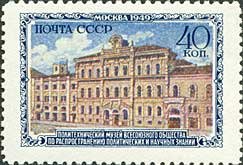Stamp: Polytechnic Museum (Soviet Union, USSR 1950)
Polytechnic Museum (Soviet Union, USSR 1950)
28 March (Soviet Union, USSR ) within release Moscow museums goes into circulation Stamp Polytechnic Museum face value 40 Russian kopek
| Stamp Polytechnic Museum in catalogues | |
|---|---|
| Michel: | Mi:SU 1453 |
Stamp is horizontal format.
Also in the issue Moscow museums:
- Stamp - State Historical Museum face value 40;
- Stamp - Timiryazev State Museum of Biology face value 40;
- Stamp - Zoological Museum of Moscow State University face value 40;
- Stamp - Polytechnic Museum face value 40;
- Stamp - State Tretyakov Gallery face value 40;
- Stamp - State Museum of Oriental Cultures face value 40;
- Stamp - State Museum of Revolution face value 40;
- Stamp - Pushkin State Museum of Fine Arts face value 40;
- Stamp - Central Lenin Museum face value 40;
|
Data entry completed
83%
|
|
|---|---|
| Stamp Polytechnic Museum in digits | |
| Country: | Soviet Union, USSR |
| Date: | 1950-03-28 |
| Size: | 39 x 27.5 |
| Perforation: | 12¼ |
| Format: | Stamp |
| Face Value: | 40 Russian kopek |
| Print run: | 1000000 |
Stamp Polytechnic Museum it reflects the thematic directions:
Tourism is travel for pleasure or business; also the theory and practice of touring, the business of attracting, accommodating, and entertaining tourists, and the business of operating tours. Tourism may be international, or within the traveller's country. The World Tourism Organization defines tourism more generally, in terms which go "beyond the common perception of tourism as being limited to holiday activity only", as people "traveling to and staying in places outside their usual environment for not more than one consecutive year for leisure, business and other purposes". Tourism can be domestic or international, and international tourism has both incoming and outgoing implications on a country's balance of payments. Today, tourism is a major source of income for many countries, and affects the economy of both the source and host countries, in some cases being of vital importance.
Architecture (Latin architectura, from the Greek ἀρχιτέκτων arkhitekton "architect", from ἀρχι- "chief" and τέκτων "builder") is both the process and the product of planning, designing, and constructing buildings and other physical structures. Architectural works, in the material form of buildings, are often perceived as cultural symbols and as works of art. Historical civilizations are often identified with their surviving architectural achievements.
Technology is the application of conceptual knowledge to achieve practical goals, especially in a reproducible way. The word technology can also mean the products resulting from such efforts,including both tangible tools such as utensils or machines, and intangible ones such as software. Technology plays a critical role in science, engineering, and everyday life.
A museum (/mjuːˈziːəm/ mew-ZEE-əm) is an institution dedicated to displaying and/or preserving culturally or scientifically significant objects. Many museums have exhibitions of these objects on public display, and some have private collections that are used by researchers and specialists. Compared to a library, a museum hosts a much wider range of objects and usually focus around a specific theme such as the arts, science, natural history, local history, and other topics. Public museums that host exhibitions and interactive demonstrations are often considered to be tourist attractions, and many museums attract large numbers of visitors from outside their host country, with the most visited museums in the world regularly attracting millions of visitors annually.
A building or edifice is a structure with a roof and walls standing more or less permanently in one place, such as a house or factory. Buildings come in a variety of sizes, shapes and functions, and have been adapted throughout history for a wide number of factors, from building materials available, to weather conditions, to land prices, ground conditions, specific uses and aesthetic reasons. Buildings serve several needs of society – primarily as shelter from weather, security, living space, privacy, to store belongings, and to comfortably live and work. A building as a shelter represents a physical division of the human habitat (a place of comfort and safety) and the outside (a place that at times may be harsh and harmful).





